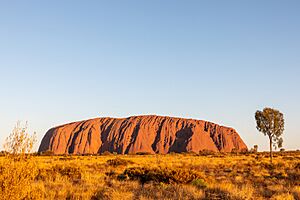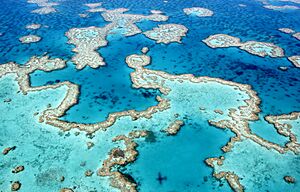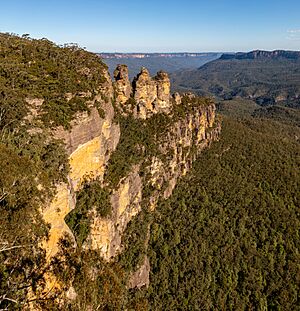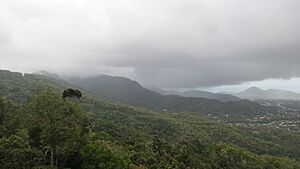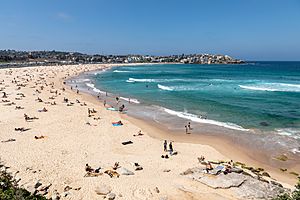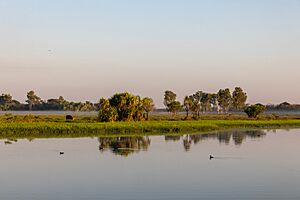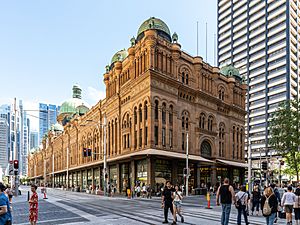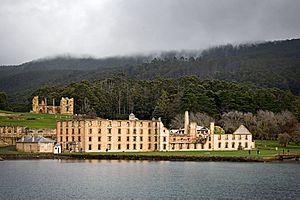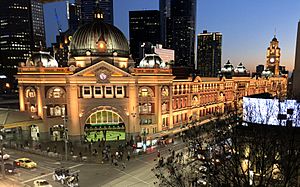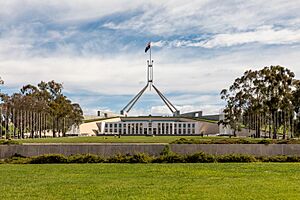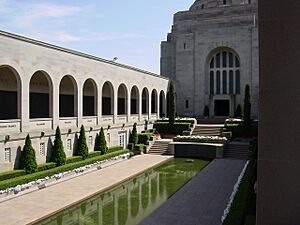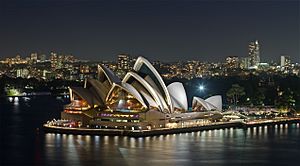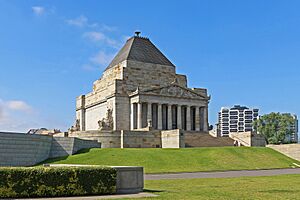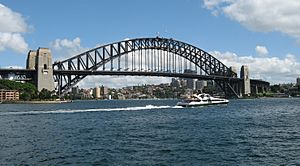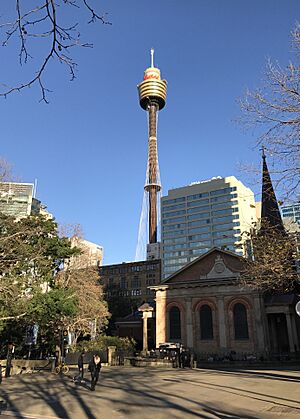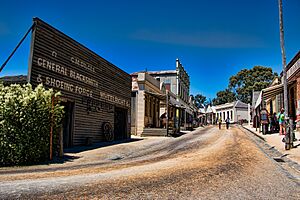Monuments of Australia facts for kids
Australia has many amazing monuments! These can be statues, fountains, special buildings, or even incredible natural places. Some of these monuments are important to the whole country, while others are special to local communities. Their main job is to help us remember important things from the past, like how Australia was settled, local industries, or even sports. These monuments show us Australia's history and help tell its story.
Even though much of Australia is desert, most people live in cities. These cities have some really cool monuments too!
Contents
- Amazing Natural Monuments
- Important Buildings and Sites
- Early 1900s Landmarks
- Modern Australian Monuments
- Parliament House: Where Australia's Laws Are Made
- Australian War Memorial: Remembering Service and Sacrifice
- Sydney Opera House: A World-Famous Icon
- Shrine of Remembrance: Honouring Those Who Served
- Sydney Harbour Bridge: The Coathanger
- Sydney Tower: High Above the City
- Sovereign Hill: Step Back in Time to the Gold Rush
- Other Australian Monuments
Amazing Natural Monuments
Uluru: Australia's Giant Red Rock
Uluru is a huge sandstone rock in the Northern Territory. It's about 450 kilometres from the closest big town, Alice Springs. This amazing rock is a protected World Heritage Site. It's also a very sacred place for the local Indigenous people, the Pitjantjatjara. Uluru has been a popular spot for tourists since the 1930s, with over 250,000 visitors every year! The area around Uluru is also known for its unique plants and animals.
How Uluru Was Formed
Scientists believe Uluru started forming about 1.5 billion years ago! Over millions of years, different geological events slowly shaped it into the giant rock we see today. It was fully formed around 300 to 400 million years ago.
Why Uluru is Special to Aboriginal People
Uluru is also known as Ayers Rock. This name was given by an explorer named William Gosse in 1873, honouring the governor at the time, Sir Henry Ayers. However, the name Uluru is much older, given by the local Pitjantjatjara people almost 10,000 years ago!
For Aboriginal Australians, their creation stories (called the Dreaming) say that the Earth took shape when ancestors sang and created rocks and other features. These creation songs are still sung today on special journeys called Songlines, which help people stay connected to the land. The shapes and marks on Uluru's surface are believed to show events that happened there long ago.
Visiting Uluru Today
Uluru is a UNESCO World Heritage Site and a huge tourist attraction. More than 300,000 people visit it each year. For a long time, tourists could climb Uluru. However, at the request of the Aboriginal elders, climbing Uluru is now not allowed. This decision was made to respect the cultural importance of the site.
To make sure the climb was removed safely and respectfully, the Uluru Kata Tjuta National Park board made sure that no visible signs of the old climbing posts would remain. They also ensured that the rock itself wouldn't be damaged.
Great Barrier Reef: An Underwater Wonder
The Great Barrier Reef is a massive system of coral reefs and marine life located off the coast of Cairns, Queensland. It's the biggest reef system in the world, stretching over 344,400 square kilometres! It's so huge you can even see it from space. The reef is considered one of the Seven Natural Wonders of the World and became a World Heritage Site in 1981. It's incredibly important to local Aboriginal and Torres Strait Islander people, with cultural ties going back 40,000 years.
Blue Mountains: Sydney's Scenic Backyard
The Blue Mountains are a series of mountains just west of Sydney, New South Wales. They are part of the much larger Great Dividing Range that runs along Australia's east coast. The Blue Mountains have a rich Aboriginal history, being home to the Gundungurra and Darug peoples. In 2000, about 10,000 square miles of the Blue Mountains were listed as a World Heritage Area.
Daintree Rainforest: Ancient Green Paradise
The Daintree Rainforest in Queensland is Australia's largest rainforest, covering about 12,000 square kilometres. It became a World Heritage site in 1998 and attracts over 400,000 visitors each year. This rainforest is one of the oldest in the world, dating back nearly 180 million years! It's home to many unique plants, animals, and ecosystems found only in Australia.
Bondi Beach: Sydney's Famous Shoreline
Bondi Beach is a very popular spot in Eastern Sydney, stretching for about 1 kilometre. It's a big part of Australian culture, famous for sports events like the City2Surf race and TV shows like Bondi Rescue. The area was originally home to local Aboriginal and Torres Strait Islander people, as shown by ancient rock carvings. Today, it's one of Australia's biggest tourist attractions, with over 2.7 million visitors in 2016.
Kakadu National Park: A Land of Culture and Nature
Kakadu National Park is in the Northern Territory and covers almost 20,000 square kilometres. It's a place of incredible nature, with nearly 2,000 types of plants and thousands of different animal species. It's also very important because of the local Indigenous population, who have lived there for almost 40,000 years. Their culture is deeply connected to the park's natural features, and you can see amazing rock art throughout the park.
Important Buildings and Sites
Queen Victoria Building: A Historic Shopping Centre
The Queen Victoria Building (QVB) in Sydney is a beautiful building from the late 1800s. It's built in a style called Federation Romanesque and is mainly a shopping centre today.
The QVB's Story
The Queen Victoria Building was designed by architect George McRae in 1888. Construction began in 1893 and finished in 1898. It had three floors and two hundred shops.
In 1959, there was a plan to knock down the building and replace it with a car park! But in 1971, the Sydney Council decided to keep it because of its important history.
In 1980, a Malaysian company called Ipoh Garden Berhad agreed to restore the building. They spent a lot of time and effort bringing it back to its original glory. It reopened in 1986 and quickly became one of Sydney's most popular shopping spots and tourist attractions.
The QVB is also a memorial to Queen Victoria. There's a statue of her outside that was originally in Dublin, Ireland. After Ireland became independent, the statue was moved to Sydney and unveiled in 1987. Queen Elizabeth II, Queen Victoria's great-great-granddaughter, even visited it a few months later.
The land where the QVB stands originally belonged to the Cadigal and Wangal tribes of the Eora nation.
The QVB Today
In 2010, the Queen Victoria Building was added to the New South Wales State Heritage Register, making it an official heritage site. In 2018, the building celebrated its 120th birthday with a special night-time party.
Port Arthur: A Convict History Site
Port Arthur is a historic convict settlement located about 97 kilometres south of Hobart in Tasmania. It's a powerful reminder of British settlement in Australia and is one of Australia's oldest tourist attractions. The site includes many important buildings like the asylum, commander's house, and hospital, all telling the story of Australia's convict past. Port Arthur is a monument that helps Australians remember their country's early history.
Early 1900s Landmarks
Flinders Street Station: Melbourne's Busy Hub
Flinders Street railway station is a famous train station in Melbourne's city centre. It started being built in 1899 and was finished in 1910. It's one of Melbourne's most well-known and used public buildings. Its design mixes different styles, making it Australia's largest building front (façade).
Flinders Street Station's Past
There's a fun myth that the station's plans were accidentally swapped with plans for a station in Mumbai, India! This story probably came from old newspapers talking about exotic railway designs.
In 1933, a special nursery for children opened on the second floor of the station. Parents could leave their young children there for the day. It was one of only three such nurseries in the world at the time! Even though it was open for less than nine years, 55,000 children visited it.
The land where Flinders Street Station was built belongs to the Boonwurrung people, who are part of the Kulin nation.
Flinders Street Station Now
In 2015, the Victorian Government announced a $100 million plan to improve Flinders Street Station. This money was used to fix platforms, entrances, toilets, and information displays. There are also plans to repair older parts of the station, like the ballroom.
In 2018, a new entrance was built to help manage the crowds of people. The station's security system was also improved. More than 240 new CCTV cameras and a new alarm system were installed in the station's underground tunnels (the City Loop). This helps stop people from entering the tunnels illegally, which used to cause many train delays. Since the alarm system was turned on in 2019, these incidents have greatly reduced.
Modern Australian Monuments
Parliament House: Where Australia's Laws Are Made
Parliament House is in Canberra, Australia's capital city. It's where the Australian government meets to make laws. The building was finished on Australia Day, 26 January 1988, and officially opened by Queen Elizabeth on 9 May 1988. This building is very important because it's where the Australian Parliament works. It has many rooms, like the Senate and House of Representatives, and is designed to welcome visitors.
Building Parliament House
Before the current Parliament House opened, the Australian Parliament met in the Old Parliament House. Former Prime Minister Malcolm Fraser started the building of the new Parliament House on Capital Hill. Over ten thousand people worked on its construction, and most of the materials used were from Australia. The building cost $1.1 billion and is one of the largest buildings in the southern hemisphere.
The Parliament House was built into a hill. This meant a lot of digging, with over a million cubic metres of soil and rock moved! All the plants and landscaping around the Parliament House are artificial, not natural.
The Parliament House was built on the land of the Ngunnawal people.
Parliament House Today
Some people have criticised the design of Parliament House. Former Prime Minister Malcolm Turnbull felt that the building was too large and didn't have enough "collision space" where politicians from different parties could easily meet and discuss important issues. He believed the design didn't help people come together to talk and find solutions.
Australian War Memorial: Remembering Service and Sacrifice
The Australian War Memorial is a monument in Canberra. It honours the armed forces and other organisations who served in the World Wars. It was opened in 1941 by Prime Minister John Curtin, thanks to the efforts of C.E.W. Bean. This memorial reminds Australians of their country's service during the World Wars, making it a symbol of Australian identity and pride. It has many important parts, like the Commemorative Area, Memorial Building, and Sculpture Garden, all of which have special meaning. It's located at the end of the Remembrance Driveway/Anzac Parade.
Sydney Opera House: A World-Famous Icon
Located in Sydney, the Sydney Opera House is a famous performance building known for its unique architecture and its role in Australia's performing arts. It's one of the country's biggest attractions and is listed as a World Heritage Site as a "masterpiece of 20th century architecture." The building opened on 20 October 1973 and is visited by about 1.2 million people each year.
Shrine of Remembrance: Honouring Those Who Served
The Shrine of Remembrance is in Victoria and is one of the biggest memorial sites in Australia. It was finished on 11 November 1934. Since then, it has been used for important observance days like Anzac Day and Remembrance Day. The main purpose of the memorial is to honour the men and women who served in the World Wars, especially World War 1. It's also a place for education, reminding the Australian public in Victoria of their service.
Sydney Harbour Bridge: The Coathanger
The Sydney Harbour Bridge is one of Australia's most recognised monuments, with over 10 million people visiting it each year. The Bridge was finished and opened in 1932. On 19 March 2007, it was added to the Australian National Heritage Listing. The Bridge is one of the main roads into the city centre and a huge tourist attraction, offering experiences like The Bridge Climb.
Sydney Tower: High Above the City
Also known as the Sydney Tower, this building is in Sydney's city centre. It's famous for being the tallest building in Sydney and the second tallest observation tower in the southern hemisphere. Construction began in 1975, and it opened to the public in 1981. Since then, it has been part of many important cultural events, including the 2000 Sydney Olympic Games. It stands as an important monument to the Australian people.
Sovereign Hill: Step Back in Time to the Gold Rush
Sovereign Hill is an outdoor museum that recreates life during and after the Gold Rush in Ballarat, Victoria, in the mid-1800s. It opened in 1970 and covers almost 15 hectares. The site includes places like bars, cafés, and museums. Sovereign Hill regularly has real-life re-enactments of daily life from that era, and over 200,000 people visit it every year.
Other Australian Monuments
| Name | Location |
|---|---|
| Big Pineapple | Woombye, Queensland |
| Big Ram | Goulburn, New South Wales |
| Big Banana | Coffs Harbour, New South Wales |
| Kangaroo Island | Kangaroo Island, Australia |
| Melbourne Cricket Ground | Melbourne, Victoria |
| Shark Bay | Western Australia |
| Royal Botanical Gardens | Sydney |
| Twelve Apostles | Port Campbell National Park, Victoria |


